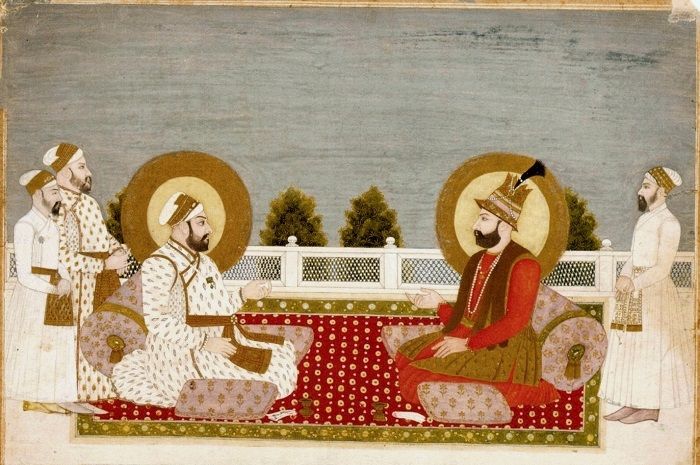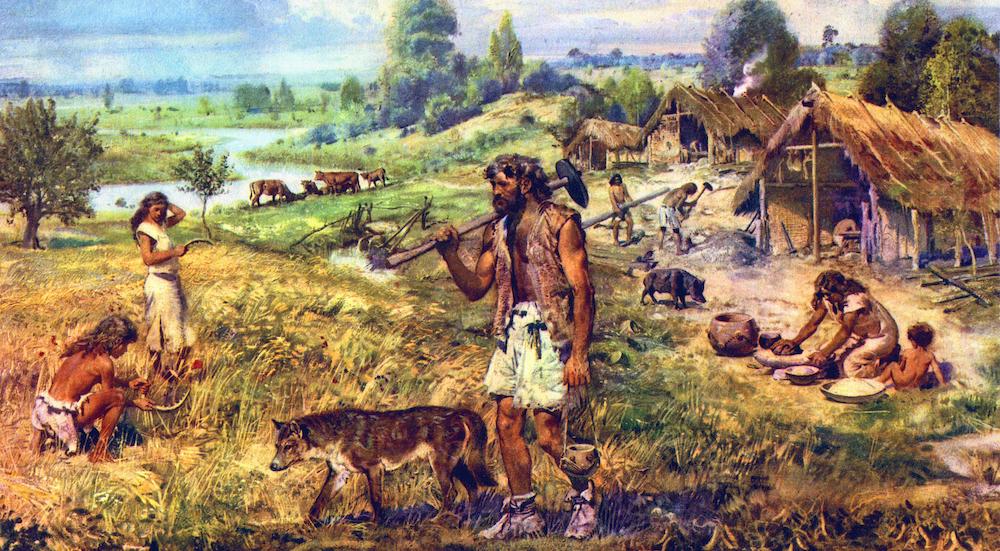- Visitor:85
- Published on:
The Mughal Empire – An ‘Islamicate’ State Form.
Saumya Dey debunks the theory of a “syncretic” Mughal Empire and shows that the Mughal empire was thoroughly Islamic in almost every sphere.

Understanding the ‘Islamicate’
The term ‘Islamicate’ was originally coined by Marshall Hodgson, the author of a monumental three volume history of Islam. He attributed to it the following meaning – “a culture, centered on a lettered tradition, which has been historically distinctive of Islamdom the society, and which has been naturally shared in by both Muslims and non-Muslims….”[1] Simply put Hodgson, primarily understood the ‘Islamicate’ not in the religious sense but as a literary, or literate, tradition, historically characteristic of Muslim society, but which could potentially include non-Muslims in its fold. Like Hodgson, I too shall not use the ‘Islamicate’ to denote Islam, the religion, alone. However, like him I shall not restrict its meaning to a literary, or literate, tradition either. Instead, by the ‘Islamicate’ I shall broadly mean ‘the culture of Islamdom’, a phrase Hodgson uses elsewhere.[2] As I understand, as ‘the culture of Islamdom’ there would be mainly three components to the ‘Islamicate’ – conceptions of kingly power and sovereignty (formulated with reference to Islam), a high culture in which the Persian language played a key role (liable to be imagined, as well shall see below, as the language of Islam), attitudes towards non-Muslim religiosity and cultural displays (frequently censorious), and spiritual practices (encompassing every form of puritanism and Sufism). In each of these four forms the ‘Islamicate’ was capable of yielding rich symbolism and determining the character and appearance of a state.
The ‘Islamicate’ Character of the Mughal Empire
The Mughal state manifested a conspicuous ‘Islamicate’ symbolism in every sense. Firstly, the Mughal Emperors deployed themselves as the symbols of a very specifically Islamic conception of sovereignty. For example, the Mughal capitals “Delhi and Agra were designed respectively as dar al-khalifa and mustaqarr al-khalifa, and the Mughal emperor was not infrequently called khalifa.”[3] The person of the Mughal Emperor, thus, projected the moral intent of Islam (or, one might say, a subjective perception of the same). For instance, Babur, the founder of the Mughal Empire, did not flinch from making an aggressive show of his Islamic piety. We learn from Satish Chandra, one of the foremost Indian medievalists, that he declared the battle against Rana Sanga (fought at Khanwa, Rajasthan, in 1527) a jihad. Following the battle, he also erected a heap of the enemy soldiers’ skulls.[4] Maybe, he was making a grand display of the number of ‘unbelievers’ he had slain. Thus, ‘Islam’ (not necessarily in its scripturally ‘pure’ form), serving as a datum or ideal of culturally desirable conduct (from a peculiarly Muslim point of view), generally inspired or framed the actions of the Mughal Emperors. This is as valid for the ‘liberal’ Akbar as it is for any other Mughal monarch. In 1568, after conquering Chittor, Akbar issued a proclamation reviling infidels. He also imposed the jizyah on non-Muslims in 1575[5] (later revoked). Further, the Akbar Nama and Ain-i-Akbari provide evidence of the forcible conversion of Hindus to Islam in his reign.[6] In 1579, Akbar sought to “assume the position of an interpreter of Islamic law and, in spheres where the existing corpus was silent, of a legislator” by issuing the mahzar – [7] a statement or testimony signed by theologians conceding his religious status.[8] Akbar did have a penchant for Sufism, which probably accounted for a mystical experience he had while on a hunt (in the Bollywood production ‘Jodha Akbar’ we see him undergoing it while listening to a Sufi recital). But, writes Athar Ali, this experience “was altogether within the Islamic framework.”[9] Thus, it seems legitimate to argue that Sufism did not instill in Akbar any real religious heterodoxy. Akbar’s ‘enlightened’ religious outlook, or ‘Sulh-i Kul’, too seems to have been similarly developed within an ‘Islamic framework’. As it had him employing “the terminology of Sufi silsilahs” and calling his “spiritual followers iradat-gazinan or murids”[10], Athar Ali speculates that he was perhaps “aspiring to a position analogous to a murshid, or spiritual guide of an elite set of disciples….”[11] No doubt, as historians Shashi Joshi and Bhagwan Josh write, even under Akbar “the cultural environment” of the Mughal Empire “remained suffused with Islam”.[12] The Cambridge historian C.A. Bayly too suggests that “what Akbar was perhaps trying to do was build a specifically Indian imperial patriotism in the context of the broader sovereignty of Islam”.[13]
Secondly, the Mughal Empire often curtailed the public cultural displays and religiosity of the non-Muslims. Their shrines, or ‘sacred spaces’, were thus frequently targeted for destruction or vandalism. I would term this a periodic, grand-scale ‘ritual performance’ on the part of the Mughal Emperors, laden with an ‘Islam derived’ symbolic significance. Jahangir had a Varaha temple destroyed at Ajmer during a visit to the place.[14] Further, temples were destroyed at Kangra, Pushkar and Mewar during his reign.[15] Upon acceding to the throne, Shah Jahan asserted the “fundamentally Islamic character of the [Mughal] state….”[16] He styled himself the ‘Protector of Islam’ and banned the construction of new temples.[17] In his “Sixth Regnal Year (1633), he ordered that no temple whose foundation had been laid in Jahangir’s time but had not been completed would be allowed to be completed.”[18] Shahjahan also destroyed a fair number of temples – three in Gujarat, seventy-two in Benaras and its vicinity, and four elsewhere in the province of Allahabad. A few temples were pulled down in Kashmir.[19] His son and successor Aurangzeb continued with the policy of not allowing the construction of new temples. He deviated from the policy of letting the old temples stand when he had the shrine at Somnath destroyed in 1665.[20] The destruction of old shrines by Aurangzeb became commoner in the aftermath of uprisings by the Jats and the Marathas. He, it seems, had now come to think it “legitimate to destroy even long standing Hindu temples as a measure of punishment and as a warning.”[21] Apparently, Aurangzeb “had begun to look upon the preservation of prominent temples as a kind of guarantee of good conduct on the part of the Hindus” of a particular area.[22] So, whatever limited rights to cultural display the non-Muslims possessed, it appears that they were concessions contingent on their political docility. Sometimes, it seems, Aurangzeb demolished temples just to make a point. After he annexed the state of Jodhpur in 1679 upon the death of Maharaja Jaswant Singh, many temples were demolished there by his emissary Khan-i-Jahan. This was, as it appears, “an announcement that the State was no longer being governed by a Hindu raja but had now passed into imperial hands.”[23] Certain Hindu festivals were curbed too – for example, the celebration of Holi and Dewali were banned by an imperial decree in 1665.[24] In 1672-73, Aurangzeb resumed all financial grants held by Hindus.[25] As is well-known, he re-imposed the jizyah (abolished by Akbar in his ‘enlightened’ phase) in 1679.
Thirdly, if Sanskrit was the language of cultural power preferred by the Indic state form, the Mughal state showed a preference for Persian, the ‘Islamicate’ cultural language par excellence. Akbar, for example, took an “unusual interest in promoting social, cultural and intellectual contacts with Iran.”[26] As a result, Mughal India gravitated towards Iran culturally [27] and Persian poetry flowered under the sunny Indian skies. Aziz Ahmad calls the reign of Akbar “the golden age of Persian poetry in India.”[28] Akbar also made Persian the language of administration at all levels[29](rendering it, as I would say, a conspicuous symbol of the Mughal state’s cultural persona). Probably the cultural power expressed by Persian was a reason why he chose to do so. Redounding further to its status, the Persian language even “acquired a kind of religious sanctity among Muslims.”[30] One need not imagine that the ‘Islamic’ status of Persian was a cultural phenomenon only among lower status Muslims who might have been in awe of it. The literate elite too imagined Persian as a ‘Muslim tongue’. For example, we learn that Jamat al-Din Inju, the author of the Persian lexicon Farhang-i Jahangiri, dwelt “at length on the point that Persian, together with Arabic, is the language of Islam.”[31]Anecdotal evidence suggests that the Mughal emperors were acutely conscious of the status and cultural power that Persian communicated. A language widely spoken and understood in the Mughal Empire was Hindavi, but it obviously lacked the glamour of Persian. Nor was it identified as a ‘language of Islam’. That is probably why we see that a puritanical ruler like Aurangzeb, despite knowing Hindavi, refrained from using it. Muzaffar Alam writes that he “used Hindavi only when he talked with an Indian who knew no Persian, or who had poor knowledge of the language – and even this only when it was unavoidable.”[32]
Fourthly, and finally, the Mughal state closely associated itself with the spiritual charisma of the Sufis. I see this as the equivalent of Indic rulers associating themselves with temple deities. The Mughal emperors were devoted to the Chishti Sufi Shaikhs to such an extent that we have Richard Eaton talking of a “Mughal Chishti partnership.”[33] After setting foot in Delhi, Babur had prayed at the shrine of the Chishti Shaikh, Bakhtiyar Kaki. His brother-in-law, on the other hand, rebuilt the tomb of Nizam al-Din Auliya.[34] Akbar later constructed his father’s tomb near this site. He also chose the hospice-site of Salim Chishti for his new capital, Fatehpur Sikri. Jahangir and Shah Jahan “built gates and other buildings at or near the foundational Chishti shrine at Ajmer….”[35] The Mughal dynasty, thus, writes Eaton “vigorously patronized the order” of Chishti Shaikhs believing that their blessings “underpinned their worldly success….”[36]
Could one term the Mughal rulers ‘syncretic’ in their outlook due to their partnership with the Sufis? No, not at all. Just as with the Muslim theologians, the “dissemination and consolidation of Islamic power” in the lands that the Muslims had conquered was a concern for the Sufis.[37] Indeed, the Sufis believed in the finality of the Islamic revelation and could assert as much. Sufi catholicity towards non-Muslims was, as a result, not limitless (to the extent that it existed), it was very circumscribed indeed. The Sufis could not “completely free themselves from hegemony of orthodox, juristic Islam.”[38] They too, we assume, saw the Hindus as an ‘other’ who signified fundamental cultural differences. Their involvement with the Mughal state only symbolically underlined its ‘Islamicate’ cultural persona.
I am grateful to Professor Bhagwan Josh, former faculty at my alma mater Center for Historical Studies, Jawaharlal Nehru University, under whose supervision I wrote my MPhil and PhD. I first acquired several ideas contained in this article during discussions with him. His theorization of the nature of the Mughal state was the starting point for me. One may find it in the third volume of his three volume work Struggle for Hegemony in India (cited above).
Notes and References
[1] Marshal G. S. Hodgson, The Venture of Islam. Conscience and History in a World Civilization. Vol. 1, The Classical Age of Islam (Chicago and London: The University of Chicago Press, 1977), p.58. Italics in original.
[2] Ibid., p.59.
[3] The Languages of Political Islam in India (Delhi: Ashoka University in association with Permanent Black, 2016 [fourth paperback impression]), p.14.
[4]Medieval India. From the Sultanat to the Mughals. Part Two (1526-1748) (New Delhi: Har-Anand Publications, 2000), p.44.
[5] M. Athar Ali, ‘Sulh-I Kul and the Religious Ideas of Akbar’ in Mughal India. Studies in Polity, Ideas, Society and Culture (New Delhi: OUP, 2008), p.159.
[6] Sri Ram Sharma, The Religious Policy of the Mughal Emperors (Humphrey Milford. OUP, 1940), p.16.
[7] M. Athar Ali, ‘Towards an Interpretation of the Mughal Empire’, Mughal India, p.63.
[8] M. Athar Ali, ‘Sulh-I Kul and the Religious Ideas of Akbar’, Ibid., p.159.
[9] M. Athar Ali, ‘The ‘Vision’ in the Salt Range, 1578. An Interpretation’, Ibid., p.154.
[10] M. Athar Ali, ‘Sulh-I Kul and the Religious Ideas of Akbar’, Ibid., p.163.
[11] Ibid.
[12] Struggle for Hegemony in India, Vol. 3, Culture, Community and Power (New Delhi: Sage Publications, 1994), p.171.
[13]Origins of Nationality in South Asia: Patriotism and Ethical Government in the Making of Modern India (New Delhi: OUP, 2001), p.38.
[14] The Religious Policy of the Mughal Emperors, p.73.
[15] Ibid., p.89.
[16] Satish Chandra, ‘Jizyah and the State in Indian during the Seventeenth Century’ in Essays on Medieval Indian History (New Delhi: OUP, 2005), pp.316-317.
[17] Satish Chandra, ‘State and Composite Culture in Pluralistic Society’ in State, Society, and Culture in Indian History(New Delhi: OUP, 2012), p.35.
[18] Satish Chandra, Medieval India, pp.254-255.
[19] The Religious Policy of the Mughal Emperors, p.103.
[20] Ibid., p.137.
[21]Ibid., 278.
[22] Satish Chandra, ‘Reassessing Aurangzeb’ in State, Society, and Culture in Indian History, p.132.
[23] The Religious Policy of the Mughal Emperors, p.144.
[24] Ibid., p.150.
[25] The Agrarian System of Mughal India (New Delhi: OUP, 1999), p.357. Only very occasional relaxations of the decree appear to have been made, in case of the Govind Dev temple and the priest of the Madan Mohan temple.
[26] The Languages of Political Islam in India, p.124.
[27] Ibid., p.125.
[28] An Intellectual History of Islam in India, p.76.
[29] The Languages of Political Islam in India, p.128.
[30] Ibid., p.132.
[31] Ibid., pp.132-133.
[32] Ibid., p.148.
[33] Temple Desecration and Muslims States in Medieval India (New Delhi: Hope India, 2004), p.28.
[34] Ibid., pp.26-27.
[35] Ibid., p.27.
[36] Ibid.
[37] The Languages of Political Islam in India, p.88.
[38] Ibid., p.161.
Center for Indic Studies is now on Telegram. For regular updates on Indic Varta, Indic Talks and Indic Courses at CIS, please subscribe to our telegram channel !
- 42 min read
- 0
- 0










